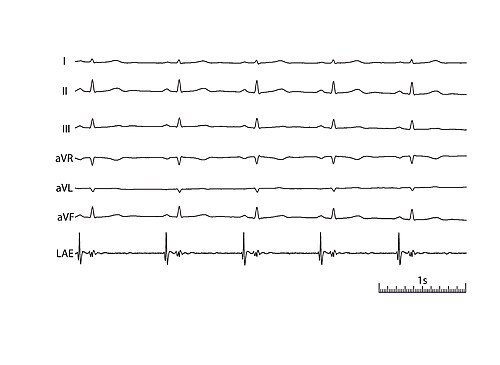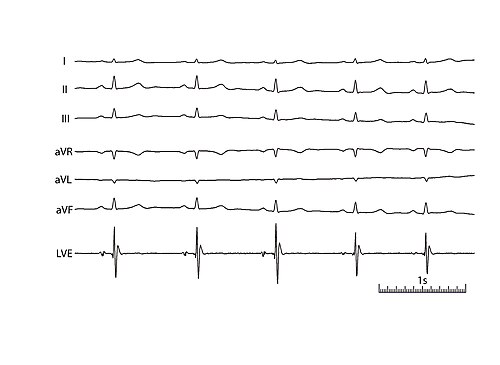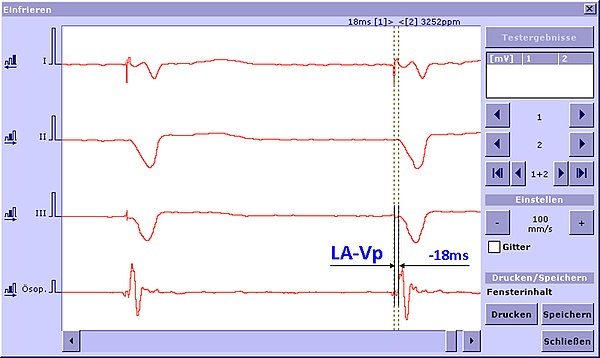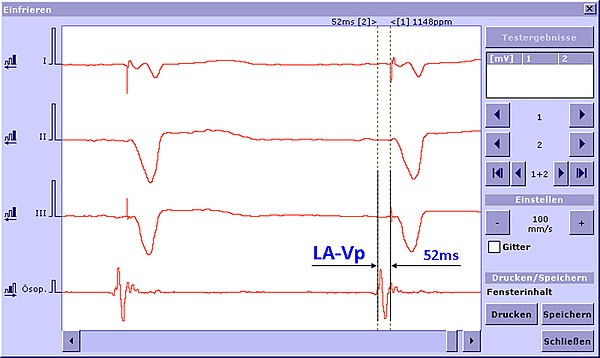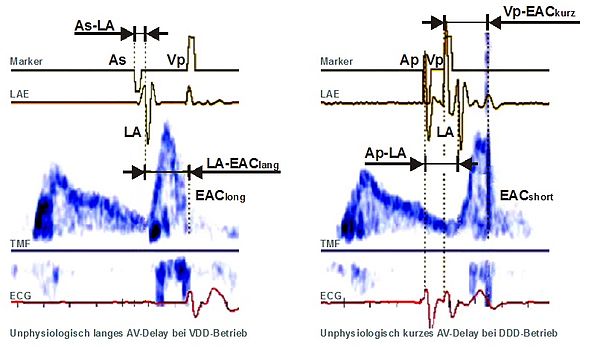Filtered esophageal left heart electrogram
The filtered esophageal left heart electrogram is a semi-invasive electrocardiographic method. This technique is able to provide additional information about left atrial and left ventricular activities.  Application of a bipolar esophageal electrodeRecording of the esophageal left heart electrograms requires a bipolar esophageal electrode. For example, the TOslim electrode (Osypka AG, Rheinfelden, Germany) can be used. It has to be applied perorally or transnasally either with or without any mild sedation. To record left atrial electrograms in adults of medium size, the electrodes are placed at a position of about 38-cm measured from the upper row of teeth. At this height, the maximum amplitude of the left atrial deflection can be expected, which is achieved by careful correction of the lead position. Then the electrode should be fixated at the chin of the patient with a plaster.[citation needed] Filtered bipolar esophageal electrogramTo eliminate artifacts in the esophageal left atrial electrogram and to improve the differentiation of the left atrial deflection from the ventricular complex, filtering with a Butterworth highpass is recommended. For instance, the Rostockfilter (Osypka AG Rheinfelden) can be used as separate electronic supplement for electrocardiographs for this purpose. It is not necessary to interconnect different devices in order to record a filtered esophageal electrogram if the programmer ICS3000 (Biotronik GmbH Berlin, Germany) is used. The esophageal electrogram recording feature of the ICS3000 offers a filtered Butterworth high-pass esophageal left atrial electrogram. In combination with the surface ECG, filtered bipolar esophageal left atrial electrogram (LAE) recording can be of advantage in all situations requiring doubtless recognition of the atrial activities.[citation needed] Maximal left ventricular deflection can be found about 3 to 5 cm deeper than maximal left ventricular deflection. The lead position should be carefully adjusted in order to record maximal left atrial or left ventricular deflections, respectively. To eliminate artifacts in the esophageal left atrial electrogram and to improve the differentiation of the left atrial deflection from the ventricular complex, a high-pass filtering is recommended. Good results can be obtained using Butterworth 15 Hz high-pass filtering. In position of maximal left atrial deflection, to achieve maximal suppression of the QRS amplitude, the lower high-pass filter frequency should be switched to 40 Hz.[citation needed]
UtilizationFiltered bipolar esophageal left atrial electrogram for rhythm analysisIn combination with the surface ECG, filtered bipolar esophageal left atrial electrogram (LAE) recording can be of advantage in all situations requiring doubtless recognition of the atrial activities. Applying bipolar electrode in esophageal position of maximal left atrial deflection and using Butterworth high-pass filtering, the LAE provides an additional “left atrial marker channel”. By this way, atrial activities can easily be recognized even if they are superimposed by the QRS complex. Thus, LAE recording can be utilized, for example, to quickly differentiate tachycardias and extrasystolies.[citation needed] Esophageal left atrial electrogram recording to detect supra-ventricular tachycardias using the ICS3000 programmer (BIOTRONIK GmbH, Berlin, Germany). Approximation of the individually optimal resting AV delay for VDD pacingThe lower tracking rate is programmed to a value below the sinus rate to achieve atrial controlled ventricular pacing. Then the AV delay is preset to an arbitrary value, but, for practical reasons, the use of a standard value (e. g. 150 ms) in all cases and in both modes is recommended. The rate adaptation of the AV delay has to be disabled.
Now approximation of the optimal AV delay is accomplished in two steps: Approximation of the individually optimal resting AV delay for DDD pacingThe lower tracking rate is programmed to a value about 10 bpm above the sinus rate to achieve AV sequential pacing. Then the AV delay for atrial pacing remains programmed to the chosen arbitrary value of 150 ms and the rate adaptation of the AV delay remains disabled.
Now approximation of the optimal AV delay takes place as in DDD pacing:
The individually optimized electromechanical intervalThis is the AV delay component that can be individually optimized. During diastolic optimization, it can be determined from the difference of two time intervals that can be measured by echo. These are the following: 1. The duration of the left atrial electromechanical action (LA-EAClong) is measured during an AV interval programmed to be non-physiologically long (about 200 ms longer than As-LA). It is measured from the beginning of the left atrial deflection (LA) in the esophageal electrogram to the undisturbed end of the left atrial contribution to the left ventricular filling (EAClong), which can be detected in the mitral flow image. 2. The duration of the left ventricular latency period (Vp-EACshort) is measured during DDD pacing with an AV interval programmed to be non-¬physiologically short (about 20 ms shorter than Ap-LA). It is measured from the ventricular stimulus Vp and the prematurely truncated end of the left atrial contribution, to the left ventricular filling (EACshort) in the mitral flow.
This description emphasises that the hemodynamic optimization of the AV delay always consists in the individual optimization of only its electromechanical share. The individual share of implant-related interatrial conduction times in the total duration of the optimal AV delay, can be considerably but must be accepted as a given. It can be influenced intraoperatively by the choice of the lead position in the right atrium. The overall duration of the optimal AV delay thus results for both modes as the sum of the implant-related individual interatrial conduction time (IACT) valid for the respective mode (VDD or DDD) and the individually optimal electromechanical interval. This advanced principle avoids all limitations and pitfalls of an AV delay optimization according to Ritter et al..
References
|
Portal di Ensiklopedia Dunia



